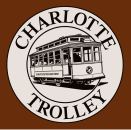Along The Trolley Line
Trolleys in Charlotte

Charlotte Trolley was founded in 1988, and began operating Charlotte’s electric streetcars again in 1996. But streetcars in Charlotte have a much longer history than that. In fact, they were an integral part of Charlotte’s development over one hundred years ago.
Charlotte’s first public transit system was managed by the Charlotte Street Railway Company, chartered in 1883 to develop and operate a streetcar line. The company laid track along West Trade and Tryon Streets, and in January 1887, three cars were put into operation, each drawn by two mules. Charlotte considered itself the epitome of the modern city, and the system prospered immediately. Horses replaced mules within the first year, and by 1891, the system included four lines of track. Then as now, the crossing of Trade and Tryon Streets at Independence Square was the focus of the "uptown" business district. The streetcar system had six cars, 20 horses, and 40 sets of harness, the fare was five cents, and ridership grew steadily. Management of the Charlotte Street Railway Company did have its day-to-day problems. In 1887, a teenager weighing 447 lbs, on his way to be an exhibit at a local fair, crashed through the floor of a streetcar, causing serious damage to the car (we don’t know what happened to the boy!). And in 1888, disaster was narrowly averted when the horses pulling a streetcar bolted from their stop on West Trade and hurtled all the way to the Square, dragging the empty car behind them. Fortunately, no one was hurt, but it must have been a sight to see. Exciting as they were, horse-drawn streetcars didn’t last long in Charlotte. By 1891, the power of electricity had captured the popular imagination, and local entrepreneur Edward Dilworth Latta saw the possibilities for an electric streetcar line. 
Latta was an acquaintance of Thomas Edison, and when Latta’s Charlotte Consolidated Construction Company, known as the Four C’s, took over the streetcar system in 1891, he immediately began plans to electrify it. The Edison Electric Company built the new system, and the first electric streetcar made a ceremonial inaugural run on May 18, 1891.
Trolley employees worked six days per week, twelve hours per day. The motormen and conductors were paid 8 cents per hour during the first two years of service, 11 cents during the third year, and 12 cents thereafter. These wages were actually better than those of North Carolina's male textile workers, who made between 40 and 50 cents per day in the 1890s. In 1896 the Charlotte Electric Railway, Light & Power Co. acquired the system from the Charlotte Street Railway Company; by 1910, Charlotte Electric Railway reported owning 19 closed and 11 open cars which were operated over 21 miles of routes with seven miles of second track. Thatyear the Southern Public Utilities Co. (SPU) bought the system. SPU eventually became Duke Power Company, which owned and operated Charlotte’s public transit system for the next 41 years. Between 1920 and 1930, Char-lotte’s population went from 46,000 to 83,000, as the textile industry continued to grow and the city expanded by taking in surrounding territory. By the time of the Great Depression, this greatly-increased population still depended on the same few miles of streetcar lines plus a fleet of independently owned and unregulated taxicabs charging a flat fare of ten cents. Finally, the public, supported by the City Council, began to demand more of the city’s transit system, and Duke Power made the decision to transition from electric streetcars to buses. On September 7, 1935, the first bus line was instituted, and the last day of streetcar service was March 14, 1938. Although Charlotte’s original streetcar tracks ran down the center of the main roads and streets of the city, today Charlotte Trolley rides on a set of railroad tracks originally laid in 1852 for the Charlotte and South Carolina Railroad, which ran from Charlotte to Columbia and then on to Charleston, South Carolina. Financed by Charlotte businessmen, this line was the first railroad track to arrive in Charlotte. The building of this railroad has been called the single most important event in Charlotte's economic history. It served as a vital railroad connection during the Civil War, and later played a critical part in the creation of Charlotte’s textile industry boom of the late 18th and early 19th centuries. 
The tracks are now used by the Charlotte Area Transit System for both the trolley and the LYNX light rail. The first miles of the trolley route parallel Camden Road, one of the oldest roads in Mecklenburg County. Named this because it led to Camden, South Carolina, Camden Road was the route along which General Charles Cornwallis and the British Army moved when they occupied Charlotte during the Revolutionary War.
Many thanks to the Charlotte-Mecklenburg Historic Landmarks Commission for the historical information included above. |
